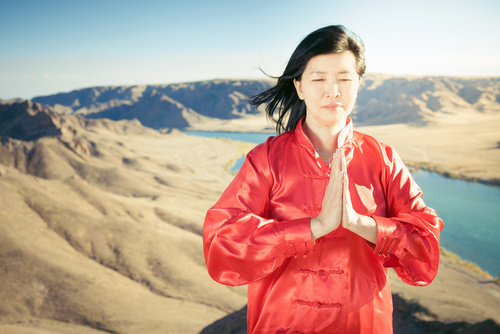The rules on which Qi Gong is based are conveyed through the exercises and gradually become visible and understandable in everyday life. At the same time, they are a tool for rearranging and rhythmizing your own life. An improved self-perception can arise and an expanded perception and assessment of the outside world promote the serenity of the practitioner.
Certainly, people in China have always known how effective and sustainable the exercises are for health. Because monks have been demonstrably using these methods for more than 2500 years. The physical health that is supported with the daily practice of such exercises was an essential pillar of their cultivation work. And originally such exercises were only passed on in secret from a teacher to a student.
Determined by this healing power and the fact that the influence of the western world on ancient China increased in the 20th century, the first Chinese script came in 1914, which recommended the therapeutic use of the traditional exercises in a modern sense. In the early 1950s, this idea was taken up by the state and the traditional exercises for the benefit of general health were promoted.It was not only quickly spread in Chinese clinics and hospitals, but also in innumerable self-help groups among the general public, as well as worldwide.
Over the many centuries that these exercies have been practiced and refined in Daoist and Confucian monasteries, they have also been part of Chinese martial arts, and in China these forms of self-cultivation have always been associated with medicine. Monasteries were traditionally places of healing and retreat for the sick and seekers, and it was not uncommon for wise and withdrawn people to be particularly respected healers and herbalists. Dealing with wounds and injuries played an extremely important role in martial arts, and knowledge and experience about it were carefully passed on to the next generation. In this way, extensive knowledge of the various medical procedures has accumulated over thousands of years. In addition, Buddhism has been widespread in China via the Silk Road, for example since the time around the birth of Christ, and has left its mark on typical Chinese practices.
Qi Gong not only finds an important place in the recovery phase after illness, but it is also important in prevention.In Qigong, one does not pay so much attention to individual symptoms, but to the idea of ​​an inherent unit that should be striven for and improved with every Qigong exercise.
Working with the Qi – that is the literal translation for „Qi Gong“ – is the fluid balance of forces that always follows the circular shape.At the same time, the breath follows the shape of a wave. He enters and leaves the body alternately. Breathing in  balance, people relax sustainably and deeply.Qi Gong promotes the mobility of the joints outside and at the same time keeps the five senses healthy until old age. Inside, it connects people with their soul powers again through the breath. Breath, movement and ideas are the three pillars of a successful Qi Gong practice.
Trained therapists and Qi Gong teachers can instruct patients in specific exercises and accompany their learning.These exercises are adapted to the physical possibilities and health requirements and should serve to support healing processes.
For legal reasons, we would like to point out:
Like most naturopathic treatments, traditional Chinese medicine is not recognized by conventional medicine in its various forms of therapy. It is not part of the general medical standard. Scientific evidence has not yet been sufficiently provided and the effectiveness has not been adequately secured and recognized.


